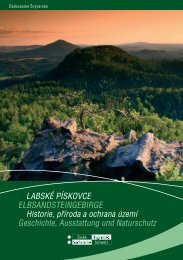ABSTRACT BOOK Sandstone Landscapes ... - Sandstones.org
ABSTRACT BOOK Sandstone Landscapes ... - Sandstones.org
ABSTRACT BOOK Sandstone Landscapes ... - Sandstones.org
You also want an ePaper? Increase the reach of your titles
YUMPU automatically turns print PDFs into web optimized ePapers that Google loves.
PMiloš Knížek 1 and Miloš Trýzna 21 Forestry and Game Management Research Institute, Jíloviště – Strnady, CZ-156 04 Praha 5 – Zbraslav,Czech Republic (knizek@vulhm.cz)2 Bohemian Switzerland National Park Administration, Research and Nature Conservation Department,Pražská 52, CZ-407 46 Krásná Lípa, Czech Republic (m.tryzna@npcs.cz)Bark beetles on white pine in Bohemian Switzerland National ParkThe main coniferous tree species in the Bohemian Switzerland National Park are Norway spruce (Piceaabies), Scotch pine (Pinus silvestris) and white pine (Pinus strobus). While the first two species are nativein the region, Pinus strobus belongs to the introduced exotic species. Because of the mission andmanagement rules in the national park, the target stage is the forest stands consisting of native tree speciesonly. Pinus strobus is eradicated therefore. On the places where removing of cut trees is difficult, logs areleft on site. No chemical treatment is used within the national park. It developed the questions, if possiblebark and wood boring insects, mainly bark beetles, attracted to this host material could increase theirpopulation density and make some additional damages on native tree species in neighboring standsconsequently. The bark beetle species synusia on cut wood are observed and the risk of this management toother conifer tree species is evaluated. The most frequent insect species are Ips amitinus (Eichhoff) andPityogenes chalcographus (L.) here.PLenka KopřivováDepartment of Botany, Charles University, Benátská 2, CZ-128 01 Praha 2, Czech Republic; contactaddress: Švédská 2504, CZ-272 01 Kladno 2, Czech Republic (tulenka@seznam.cz)The effect of burial by sand on vegetation of sandstone regionsIn sandstone rocks, burial by sand is a regular event influencing the physical and biotic microenvironmentof plants. In this study, the effect of sand deposition on vegetation structure and the response of individualplant species to burial were investigated. Structure of natural sand deposits was observed and two types ofpermanent-plots with burial treatments (burial by sand to depth of 5 cm and both aboveground andbelowground biomass removing) were established.Two types of responses to burial were observed. First, buried plants regenerated, and new shoots penetratedthe sand deposits. Their cover restored soon after the treatment. Species showing this type of responseoccurred on the natural sand deposits in early stages of succession. It was common for rhizomatous plantswith clonal integration, such as Calamagrostis villosa and Polytrichum commune. Second, buried plantsdied off, and disturbed patches were colonized by lateral growth of adjacent populations. Their coverrestored slowly. These species became abundant in later stages of succession. It was typical of everygreenplants with aboveground rhizomes and shallow roots, such as Deschampsia flexuosa, Polytrichumformosum and Sphagnum spp. Besides these, spreading by diaspores took place, primarily in speciestypical of bare sand and woody species.




